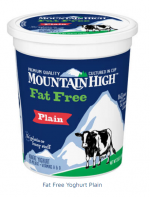Proper Greek yoghurt is around 10% fat, which is why it tastes so darned good.
Quite the controversy, Sofia advertises that she uses 2% milk but a customer actually, at his own expense, sent a sample to a food lab at one of the local universities. The goodness is indeed the 20% fat, I told her in person that it is wonderful in Indian cooking and she just stared at me, in fact it subs for numerous things.
I have Sofia that's all I need, 100% sheep and goat milk at $8 a quart finished I don't see how it could possibly be worth it or even get the ingredients. Sophia's Greek Pantry - The Pantry
EDIT - Sorry I read your link Sophia makes a yogurt with her own special step of using rennet like a farmers cheese, the result has 20% fat not at all a diet product.
I have taken to calling "no fat" (insert food product here) as "no fun" (insert food product here). So this is right up my alley.
Former CBC Radio host Danny Finkelman, on his program "Finkelman's 45s" used to say "No fat, no salt, no flavour".
I have a book written by a doctor that says no advantage in low fat yoghurt. He's game for experimenting on himself and one gave himself a tapeworm to see what happened.
What is strained out is the whey, leaving solids behind. By eyeball estimation: you fill the strainer with 1 quart of yogurt, and 48 hours later, when you discard the separated whey, the level in the container has gone down about 15% to 20%. So the final product is 15 to 20% more expensive, per cubic centimeter, than plain yogurt. At our market anyway, that's cheaper than premade Greek yogurt.
If you strain full-fat yogurt you get full-fat yogurt cheese, and if you strain nonfat yogurt you get nonfat yogurt cheese. Both are good, IMHO.
One advantage of straining is: there are many, many more choices and brands of plain yogurt, than Greek yogurt. So you have many more opportunities to find one whose taste you really like. Different brands and different yogurt makers use different yogurt cultures (lactobacillus etc.), resulting in different final flavor profiles. The more choices, the more likely you'll love one or more. Whereas with Greek yogurt, you either purchase Brand A, or Brand B, or Brand C, or else pound sand up your zass.
After trying 15 or so different brands, we decided the one below gave the best tasting yogurt cheese. Other people will have other favorites of course.
_
If you strain full-fat yogurt you get full-fat yogurt cheese, and if you strain nonfat yogurt you get nonfat yogurt cheese. Both are good, IMHO.
One advantage of straining is: there are many, many more choices and brands of plain yogurt, than Greek yogurt. So you have many more opportunities to find one whose taste you really like. Different brands and different yogurt makers use different yogurt cultures (lactobacillus etc.), resulting in different final flavor profiles. The more choices, the more likely you'll love one or more. Whereas with Greek yogurt, you either purchase Brand A, or Brand B, or Brand C, or else pound sand up your zass.
After trying 15 or so different brands, we decided the one below gave the best tasting yogurt cheese. Other people will have other favorites of course.
_
Attachments
Last edited:
Other people will have other favorites of course.
_
No criticism intended but I prefer sheep and goat yogurt and kefir plain only, just a personal preference. Similar to ice cream has 4 ingredients milk+heavy cream, egg yolks, cane sugar, real vanilla, nothing else allowed (at all). Just me no big deal.
I make my yogurt with whole milk (US 3%) with powdered milk added.
I use Act**ia as a starter culture.
I leave it in an insulated "Cooler" with water bath at 110F for 18-24 hours, pulling a quart of water and microwaving it and pouring it back every hour for the first 6 hours to stabilize the temperature.
I will have to try adding heavy cream in the next batch.
I use Act**ia as a starter culture.
I leave it in an insulated "Cooler" with water bath at 110F for 18-24 hours, pulling a quart of water and microwaving it and pouring it back every hour for the first 6 hours to stabilize the temperature.
I will have to try adding heavy cream in the next batch.
We never used eggs in Ice cream. Fruit, Whole milk, Cream, Sugar and Vanilla (Vanilla goes in every desert).
I substitute my Yogurt for buttermilk in recipes that call for buttermilk. Biscuits, Fried Chicken, Cornbread, you know... staples.
Cornbread I have never understood. I first got some when, early in my stint in Chicago I went to boston market and, with the chicken dinner came a couple of yellow blocks of something that to me looked like sponge cake. I had to ask someone at work next day to explain it to me. It is just completely alien to my reference points. I also suspect boston market cornbread is to the real stuff as expanded polystyrene is to food!
Bill, order cornbread in any non-chain restaurant in Biloxi Mississippi or Athens Georgia or Rogers Arkansas. Don't order the deep dish pizza in the South and don't order the cornbread in the North. Duh.
I also suspect boston market cornbread is to the real stuff as expanded polystyrene is to food!
Probably not really, sponge cake or genoise it is not. Mass quantities of butter go a long way. SY would say never order deep dish pizza anywhere.
Last edited:
SY would say never order deep dish pizza anywhere.
There is no accounting for taste, and SY doesn't like mayo, furthermore,
there is great deep-dish pizza in Chicago, not NYC.
There is no accounting for taste, and SY doesn't like mayo, furthermore,
there is great deep-dish pizza in Chicago, not NYC.
May you indulge in squid ink pizza with Kewpie mayo in Japan. 🙂 or...
If baby anchovies seem too normal of a pizza topping and you’re looking for something even more bizarre, shirako may be the Japanese pizza topping for you. In English it’s known as “cod milt”, which is the polite term for cod fish sperm. Shirako is milky and white, with a lightly fishy flavor—even many Japanese people consider it an acquired taste.
Try: Shirako pizza with Japanese leek, Gorgonzola cheese and dried parsley.
Mentaiko is a marinated cod roe or pollock roe. Frequently used in Japanese wafu (Japanese-style) pasta dishes, but you can also find it on pizzas in Japan.
Try: Mentaiko pizza with broccoli and Japanese mayonnaise; Mentaiko pizza with mozzarella cheese pizza and shiso chiffonade.
Last edited:
A relative spent years in Brazil where they boiled condensed (in small explodeable cans) to make doce de leite which ended up like latex but with a much sweeter taste!
I do Dulce de Leche in the pressure cooker. Sweetened condensed milk in the sealed can on a rack in the cooker, water to cover, 40 minutes at pressure, then allowed to cool slowly so the cans don't explode. Add scalded milk and cream, vanilla and sugar, chill and churn it into ice cream. No eggs, no making custard, easy-peasy and really good.
We pick up groceries at the market tomorrow, tonight was "what's in the pantry"? That turned out to be a sack of "pizza dough mix" (flour & yeast) that came in a gift basket, mozzarella left over from another dinner, a can of black olives, pasta sauce from the freezer (more leftovers), and turkey smoked sausage from the fridge. 9 minutes @ 500 degrees. The mix made two pies, we only ate one with a salad on the side. Leftovers for lunch tomorrow!
Attachments
It was comfort food for us last night.
Sharp cheddar on light rye in the panini maker
Pickled green beans wrapped in deli meats
Fermented pickle spears
Shrimp & pineapple soup
Sharp cheddar on light rye in the panini maker
Pickled green beans wrapped in deli meats
Fermented pickle spears
Shrimp & pineapple soup
Last edited:
Care to elaborate on ‘shrimp and pineapple soup’ ?
We’re swimming in shrimp this time of yr! $3-$4 lb
We’re swimming in shrimp this time of yr! $3-$4 lb
Yes ..... I like rye best for grilled cheese ....It was comfort food for us last night.
Sharp cheddar on light rye in the panini maker
Pickled green beans wrapped in deli meats
Ferment pickle spears
Shrimp & pineapple soup
Had to look up " panini maker " ....
We had ' waffle irons ' that appeared the same
except for the pattern on the grill ....
- Home
- Member Areas
- The Lounge
- The food thread

